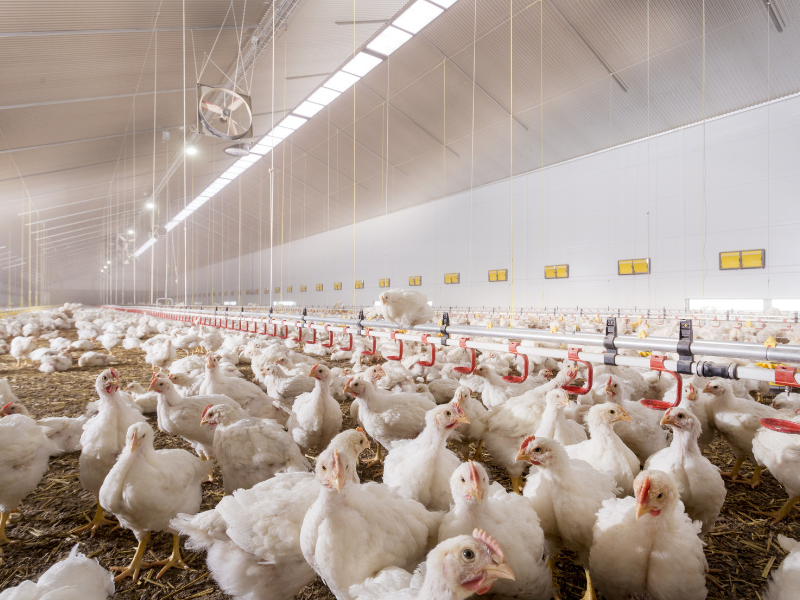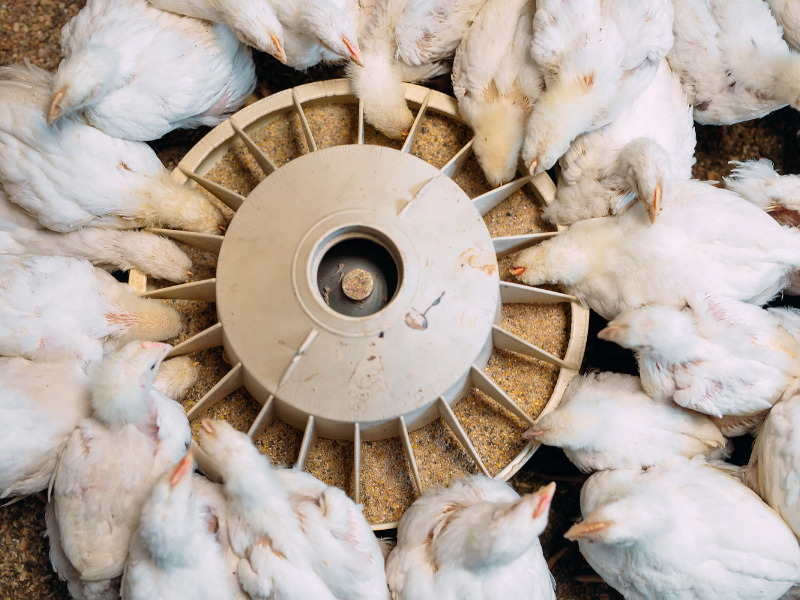![]()
Panting
Heat stress arises when birds are exposed to elevated temperatures and humidity that surpasses their capacity to maintain a stable body temperature. This situation can lead to several health issues and production losses. As birds do not have the capacity to sweat their susceptibility to these conditions is more prevalent.
Birds experience heat stress when they can no longer regulate their body temperature effectively, typically when barn temperatures exceed 26-28°C. However, early signs such as mild panting and reduced feed intake can appear even earlier, highlighting the need for proactive mitigation strategies to minimize its impact.
There are two types of heat stress:
During periods of high temperatures in the birds' house, especially in combination with high humidity, birds often show signs of discomfort and reduced productivity. These signs are easy to recognize:
![]()
Panting
![]()
Raised wings
![]()
Reduced feed intake
![]()
Increased water consumption
![]()
Decreased activity
Factors contributing to heat stress in poultry include high stocking density, high temperatures and relative humidity, and seasonal prevalence. High stocking density, with more birds in a confined space, restricts air circulation and makes it difficult for birds to stabilise body temperature. The combination of high temperature and humidity prevents birds from lowering their body temperature, leading to heat stress. Additionally, the more body weight in a house, the more heat the birds themselves produce, further intensifying overall heat stress.
Birds struggle to regulate their body temperature in high heat, especially when humidity levels rise. Since they cannot sweat, they start panting. This leads to dehydration, electrolyte imbalances, and a rise in blood pH. Even small disruptions can significantly impact their growth, productivity, and survival rates. Additionally, heat stress increases cortisol levels and disrupts the oxidative system, further compromising their well-being.
Protect your birds from heat stress with the right balance of bicarbonate, electrolytes, vitamin C, and magnesium. These essential ingredients help:
Providing electrolytes and trace elements is only effective when combined with measures to control exposure to high temperatures. To maintain optimal productivity, egg quality, and reduce mortality, it's essential to take proactive steps:

Heat stress is a major challenge in poultry farming, affecting bird health, performance, and overall productivity. High temperatures can disrupt normal physiological functions, leading to significant economic losses for producers.
Proper nutrition is crucial for maintaining poultry health and maximizing profitability. Nutrient imbalances can further compromise performance, leading to reduced productivity and financial losses.
For layers, nutritional imbalances can lead to several challenges. These include reduced eggshell quality and egg weight, as well as a lower laying percentage. The egg conversion ratio may also be compromised, impacting overall efficiency. Additionally, there can be negative effects on egg fertility, hatchability, and chick quality. Mineral imbalances, such as a calcium deficiency, can result in weaker eggshells, further affecting productivity. As conditions become more challenging, mortality rates can rise and uniformity can decline, further impacting overall performance.
For broilers, nutritional imbalances can lead to a higher feed conversion ratio (FCR), meaning they require more feed to achieve the same growth. This also results in a slower growth rate and lower final weight. Additionally, the quality of the carcass may be reduced, impacting overall production efficiency and profitability. When exposed to greater challenges, broilers are more susceptible to increased mortality and reduced uniformity, further affecting health and productivity.



Farm-O-San AHS is a carefully balanced product designed to support poultry during high temperatures or humidity, helping to maintain optimal performance by preventing dehydration and stabilizing blood values. It dissolves easily in water without fizzing and should be administered every six hours, once or twice daily, preferably in the morning or late afternoon. Formulated with essential vitamins to protect against heat stress, it contains bicarbonate to lower blood pH, sodium and potassium to replenish lost electrolytes, and vitamin C to regulate oxidative balance, reduce cortisol levels, and support immune function. Magnesium helps alleviate stress, while mint promotes clear airways and enhances feed intake.
Selko AO-mix products are a series of natural, specially formulated antioxidant blends. Helps to Improve animal performance under heat stress condition. AO-mix contains both water- and fat-soluble polyphenols. Therefore, it provides antioxidant protection both intracellular, extracellular and in the cell membranes. AO-mix can help reduce the impact of oxidative stress.
Selko pH is an antibacterial digestibility enhancer added to water to control microbial growth in warm conditions. It targets gram-negative bacteria such as E. coli and Salmonella in the water, crop, gizzard, and intestines. However, it is not suitable for reproductive animals, including laying hens.